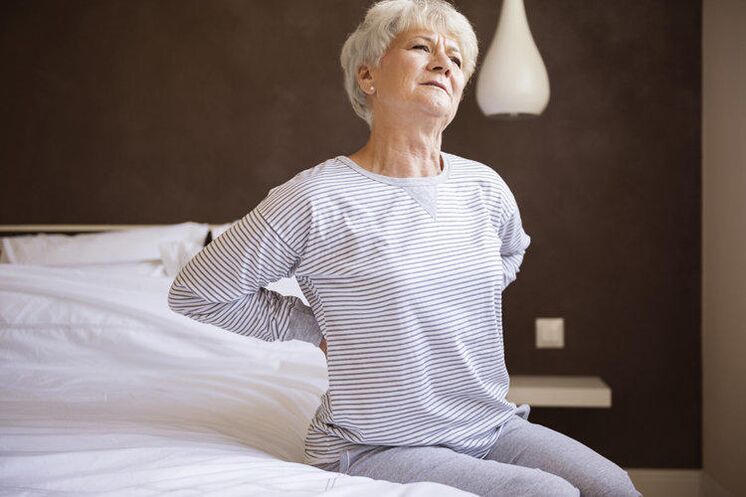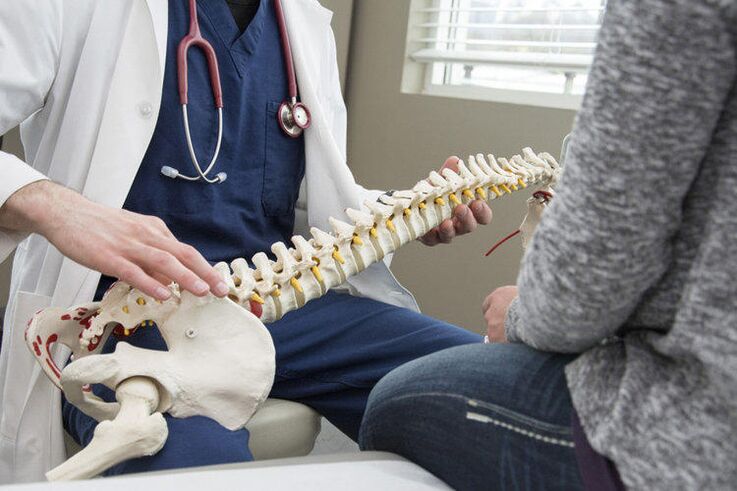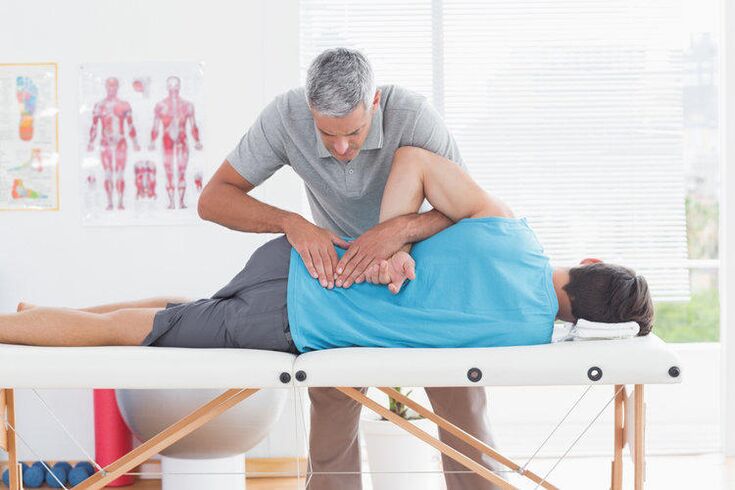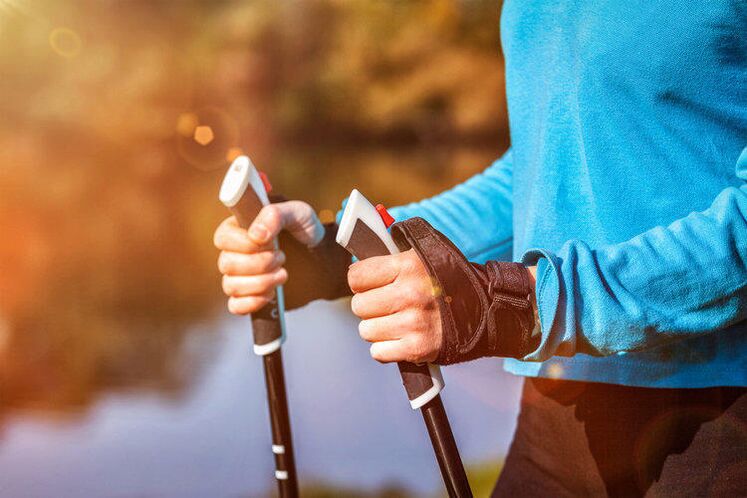Osteochondrosis is a disease in which degenerative-distribution changes are diagnosed in spinal cartilage tissues, also accompanied by structure disorders and functionality of intervertebral discs. Depending on the location of damaged tissues, cervical, thoracic and lumbar osteochondrosis are distinguished.

What is osteochondrosis?
Osteochondrosis is a spinal spinal disease where degenerative and dystrophic lesions of intervertebral discs occur. With the development of osteochondrosis, degenerative-distribution lesions apply to vertebral tissue.
The Main Feature Indicating the Development of Osteochondrosis is Pain in the Neck, Back, Lower Back Area, With Progression, The Pain "Gives" into the Hands, Chest, Shoulders, Upper Thigh, etc. With negative dynamics of osteochondrosis, atrophy of muscle tissue, impaired sensitivity, as wellsfunction of the internal organs, provoked by their suppression, provore, provore. displacement. In the absence of timely therapy, osteochondrosis develops for an incurable state.
The causes of osteochondrosis
The main factor in the development of osteochondrosis is an irregular load in the spine. The habit of carrying a bag in one shoulder or one hand, an incorrect pose in a sitting position, a dream in an excessively soft mattress, a high pillow using anatomically incorrect shoe types is a common cause of inadequate load distribution.
Additional risk factors include hypodinamia, sedentary lifestyle, overweight, back injuries, lower ends, flat feet and other musculoskeletal system disorders, as well as age -related degenerative processes in age -related changes in the blood supply of the spine.
In the etiology of osteochondrosis, the following factors can also play a role:
- Physical overtension of the body;
- Neuro -emotional exhaustion;
- Metabolic disorders, poisoning, gastrointestinal tract diseases that prevent complete nutrient assimilation;
- Professional risks, in particular, work on vibration platforms;
- genetic predisposition;
- Violations of posture during active growth, scoliosis;
- Wearing uncomfortable shoes (tight, jumps);
- prolonged and/or regular dehydration;
- lower diet, hypovitaminosis;
- Smoking;
- Pregnancy, especially multiple, in combination with an unavailed-ligation apparatus (due to the displacement of the body's center of gravity).
Osteochondrosis development stages
Osteochondrosis in the dynamics of the disease passes four stages:

- The 1st stage osteochondrosis (grade) is characterized by the early stage of the pathology in the intervertebral disc pulpics. Due to excessive load, the process of dehydration (dehydration) of the nucleus begins, which leads to a decrease in the disc parameter and the occurrence of cracks in the fibrous ring. Symptoms at this stage are usually absent, a small discomfort can occur with a prolonged permanence in an uncomfortable state pose, active movement, etc. ;
- In 2 stages, a decrease in disc height leads to a decrease in the distance between the vertebrae and the sagging of vertebrates and ligaments. This causes greater mobility of vertebrae with affected discs, which is dangerous with their displacement or slip. In the second stage of the disease, there is discomfort, pain, especially with some types of load, movements, positions;
- The stages of osteochondrosis 3 (grade) are characterized by the formation of prolapses and protrusions of intervertebral discs, can be accompanied by subluxis and/or development of arthrosis of intervertebral joints. With some types of movement, patients feel rigidity, insufficient mobility, a tingling sensation, numbness can occur in the limbs. At this stage, osteochondrosis is clearly felt on the back, neck, lumbosacro department or coccyx, depending on the location of the affected discs;
- In 4 stages of osteochondrosis, the body is trying to adjust the consequences of vertebrae hypermobility and adapt to the impaired functionality of the spine spine. Osteophytes, new bone formations, which seize vertebral fixation are formed at vertebra contact sites. However, in some cases, osteophytes may cause nerve violation, hurt the vertebrae. Fibrous ankylosis begins at intervertebral discs and joints. In the absence of microtrauma and violations of nerve roots, symptoms of the disease decrease.
Osteochondrosis symptoms
The main symptoms of osteochondrosis are a feeling of discomfort and/or neck pain, back. The severity of the sensations and the presence of additional symptoms depend on the stage of the disease. By examining the patient and collecting an anamnesis, the specialist conducts the initial diagnosis, assuming the presence of visually determined curvatosis of the spine observed in the transverse or longitudinal plane of the spine. Cervical and lumbar intervertebral disks pathologies are found much more often than degenerative and dystrophic changes in the sternum area.
Signs of osteochondrosis, felt by the patient, include a periodic or permanent sensation of fatigue in the back, erased or pronounced, depending on the stage of the disease, pain. The pain can be located on the neck, back, chest, shoulder waist, complicate, shout the upper limb movements.
The clinical image of osteochondrosis depends largely on the location of the pathology, the degree of process development, the individual characteristics of patients. Intervertebral disc pathology, displacement, protrusion, hernias and an increase in osteophytes lead to various consequences. Among the most common violations of normal blood circulation in tissues, pinching nerve endings, spinal canal dysfunction, edema, tissue fibrosis and structures are distinguished.
Such consequences can be accompanied by many different symptoms, leading to an erroneous diagnosis of disease.
The most common and characteristic symptoms of osteochondrosis include the following:
- back pain, neck, lumbar, shoulder waist, rib areas;
- discomfort, rigidity of body movements that occur in some positions of the body, inclinations, turns, increased muscle tension;
- a sense of numbness of the upper and lower ends;
- muscle and joint discomfort, muscle cramps;
- headaches, dizziness, increased fatigue;
- heart pain;
- violation of hand sensitivity;
- Muscle hypotension.
The symptoms of osteochondrosis differ depending on the location of the pathology:
- With cervical spine osteochondrosis, neck pain, hands, shoulder waist, area and shoulder irradiation prevails; Headaches, dizziness, trembling "flies" or spots in front of the eyes, noise in the ears are observed;
- With damage to the thoracic spine, the pain is located in the area of the chest, heart, inner surface of the shoulder, the armpit area, the respiratory discomfort is also observed, the shortness of breath is possible;
- Osteochondrosis of the lumbosacra spine is manifested by pain in the lower back with irradiation in the legs, the upper thighs or pelvic organs, sexual dysfunction is often united.
Superficial symptoms - back fatigue, pain - may indicate not only the presence of osteochondrosis, but also the addition of other diseases or the development of other pathological processes and disorders that are not associated with intervertebral disc dystophy. The diagnosis of osteochondrosis can only be done by a specialist, and self -medication with these symptoms is unacceptable.
Osteochondrosis diagnosis

To make a diagnosis, instrumental examination methods are used:
- Examination X -Read of the Vertebral Column Department;
- myelography;
- Neurological research of sensitivity, reflexes.
Additional methods prescribed for differentiation and clarification of diagnosis, the pathology stage includes:
- Computed tomography of the spine (CT);
- Nuclear Magnetic Resonance (JAMR);
- Magnetic resonance imaging (magnetic resonance imaging).
Therapy directions for osteochondrosis
Treatment is based on an integrated approach and, depending on the internship, lasts from 1 to 3 months of intensive care and 1 year of support for measures to consolidate the result and relapse prevention.
Osteochondrosis is performed by two directions, depending on the degree of osteochondrosis and the patient's health. Conservative treatment of the disease consists of taking medications, performing a set of exercises. Surgical treatment in almost any situation cannot be the method of first choice and is prescribed in the absence of positive dynamics, the progression of the disease in relation to the background of prolonged conservative therapy.
In addition to the therapy methods, it is necessary to follow the general recommendations for osteochondrosis: to observe a diet, take necessary measures for rehabilitation.
Conservative treatment of osteochondrosis
Conservative therapy aims to interrupt pain syndrome, normalizing the functionality of the spine spine and the prevention of negative changes
Conservative treatment of osteochondrosis includes the following types of therapy:
- Drug therapy. Drugs for osteochondrosis are used to stop pain syndromes, tissue inflammatory processes and normalize the body's metabolic processes. With pronounced pain syndrome, it is advisable to use the medicine blockade of nerve endings, which also contributes to a decrease in the severity of Tonic muscle syndrome. The following types of lock are distinguished: trigger points block, intraosseous, facet, paravertebral, epidural;
- Physiotherapy methods. Physiotherapeutic procedures help reduce pain, increase the effect of drugs, are also used during the rehab period. The most common use of ultrasound waves, magnetic fields, low frequency chains, laser rays etc.
- Physiotherapy Exercise Methods (Exercise Therapy) and Cinemaiterapia. The spice complex with regular and correct execution contributes to the correction of posture, strengthens muscle corset, ligament apparatus, normalizes muscle function, reduces compression of nerve fibers and helps prevent osteochondrosis complications. Exercise therapy methods and film procedures aim to normalize metabolic processes, restoring a complete nutrition of intervertebral discs, restoring the arrangement of vertebrae and discs between them, uniform distribution of the load in the musculoskeletal system;
- massage. Manual massage techniques are used to improve tissue blood supply, relieve muscle cramps and staples and generally improve blood circulation. Hydromassage as a direction of therapeutic activity, in addition to the listed effects, contributes to the normalization of the body's nervous system;
- Manual therapy. Manual therapy methods are selected individually. The punctual effect on the musculoskeletal system of the body helps improve blood circulation, lymph circulation, improves metabolism, promotes the mobility of the musculoskeletal system, strengthens the immune system and serves as a means of preventing osteochondrosis complications;
- Therapy with the tensile method (traction) of the spine using special equipment. The purpose of the manipulations is to increase the intervertebral space for normal parameters, correction of violations of the spinal spine structure.
Prevention of osteochondrosis

The causes of osteochondrosis are connected mainly in the absence of attention to body requirements, malnutrition, excessive loads on the body. To prevent pathological changes in the spine and restrict the dynamics of existing osteochondrosis, it is recommended to adhere to the general principles of a healthy lifestyle:
- Exception of the possibility of hypodinâmia: moderate sports: billing, running, swimming, bicycle, schis, gymnastics, non -contracting types, etc. ;
- When working or other form of activity related to a long stay in a static position, it is necessary to take breaks to warm every 45 minutes to restore blood circulation. If necessary, sitting for a long time, you should choose the right chairs to ensure the support of the spine, monitor compliance with standards for the position of the hands on the table, legs on the floor or a special support, accustomed to posture (to the back, relaxed shoulders);
- For night sleep, it is necessary to select an elastic and best orthopedic mattress with a flat surface, avoid high or very flat pillows;
- If necessary, create and/or use heavy objects to avoid pushing, raising the severity of the semi -pre -care position, use special belts that support the lower back;
- The choice of orthopedicly correct shoes: With the corresponding foot with a width, without high heels and their timely replacement will help reduce the spine load, this is especially important for women during a child's responsibility. In summer, do not neglect the ability to walk barefoot on an irregular surface, this strengthens the muscles of the foot and relieves the tension of the musculoskeletal system;
- The correct diet, the way of drinking, contributes to overall health and helps maintain metabolism normally;
- With a tendency to increase emotionality, anxiety with the spasmodic muscle reaction to stress, it is worth studying relaxation methods.















































